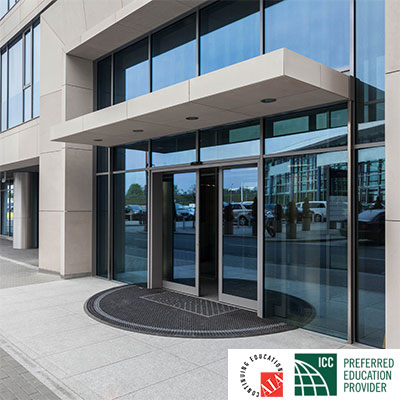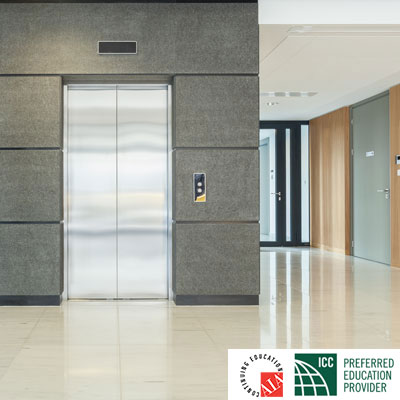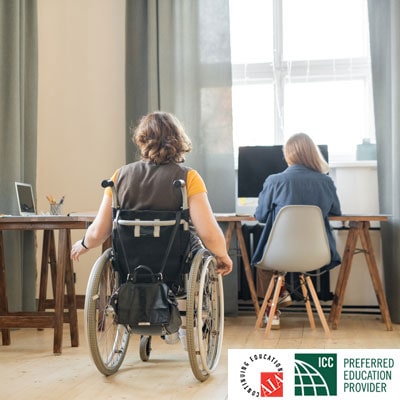Description
This 4.5 Credit package contains:
Course #1 – (7 hour Audio Course) Manage Your Way to Big Profits | #AIABLTI334.21
Course #2 – (7 hour Video Course) 2010 ADA Standards: Key Features and Elements | #AIABLTI325.20
Course #3 – (6 hour Video Course) Lead Paint Awareness | #AIABLTI333.24
Course #4 – (6 hour Video Course) 2010 ADA Standards: Real World Application Course | #AIABLTI312.24
Course #5 – (3 hour Audio Course) Getting Decked: And Choosing How That Happens | #AIABLTI451.24
Course #6 – (3 hour Audio Course) Danger in the Damp – Dealing with Mold | #AIABLTI454.22
Course #7 – (3 hour Audio Course) Successful Site Design | #AIABLTI335.5
Course #8 – (3 hour Audio Course) Successful Building Design | #AIABLTI340.5
Course #9 – (3 hour Audio Course) Successful Renovations and Additions | #AIABLTI341.5 /0.3 ICC CEU
Course #10 – (3 hour Video Course) 2010 ADA Standards: Interior Elements | #AIABLTI314.20
Course #11 – (1 hour Audio Course) Understanding and Preventing Sexual Harassment | #AIABLTI #510.23
Manage Your Way to Big Profits
Instructor: Paul Acker
This course is designed to be the next step in raising your construction management skills to the next level. The class will help prepare the learner for the scope of responsibilities that a professional construction project manager, whether for residential or commercial projects, must be prepared to perform. The course begins with preconstruction services and project start-up tasks. As the project continues, controlling the finances, overseeing the project progress, safety, environmental and energy concerns are just a few of the many tasks a project manager must supervise. Finally, a successful manager must properly close out the project, all while achieving a profit, and securing a satisfied customer.
Upon completion of this course, participants will:
- Be able to assemble a project team, ensuring they are qualified to perform the work in accordance with specifications and requirements.
- Recognize the role of OSHA in the workplace and describe the causes of the most common workplace injuries.
- Understand environmental regulations that govern construction activities for protecting water, air and land quality.
- Develop a close out procedure that will verify accuracy and completion of all building component systems, including warranties and certifications, prior to issuance of a Certificate of Occupancy.
This Course Covers:
- Planning and startup
- Project progress
- Environmental and energy concerns
- Safety
- Close out
2010 ADA Standards: Key Features and Elements
Instructor: Roger Peck
The ADA is one of America’s most comprehensive pieces of civil rights legislation that prohibits discrimination and guarantees that people with disabilities have the same opportunities as everyone else to participate in the mainstream of American life, to enjoy employment opportunities, to purchase goods and services, and to participate in State and local government programs and services. The 2010 Standards set minimum requirements, both scoping and technical, for newly designed and constructed, or altered State and local government facilities, public accommodations, and commercial facilities to be readily accessible to and usable by individuals with disabilities.
This video course covers the fourth through tenth chapters of the 2010 ADA Standards for Accessible Design. The material for this course is presented by simple narration and power point video presentation, including on-site, real world video examples in various accessible buildings used by both the public and private sector.
After completing this course participants will be able to:
- Be able recognize what exterior and interior components can and should comply with ADA standards.
- Outline at least one design strategy based on ADA standards for the construction of either a public or private building.
- Identify requirements for proper maneuvering space, clearance and accessible routes.
- Summarize the options available to the design or building professional when designing a facility per the requirements of the ADA Standards.
This course covers:
- Accessible Routes
- General Site & Building Elements
- Plumbing Elements and Facilities
- Communication Elements and Features
- Special Rooms, Spaces and Elements
- Built-In Elements
- Recreational Facilities
Lead Paint Awareness
Instructor: Scott Corbat
Traditional renovation work can create significant dust-lead hazards if lead-based paint is disturbed. Contaminated dust generated by traditional renovation work can cause lead poisoning in children, pregnant women, healthy adults, and even pets. Practical changes in work practices can minimize and contain dust. The use of lead-safe work practices makes the job safer and reduces liability exposure. This course will teach you how to perform or supervise lead-safe work practices safely and effectively. This course is not a qualifier for RRP Certification. You must complete an EPA accredited course for Certified Renovator Status.
After completing this course, you will be able to:
- Understand the dangers inherent in lead paint, including the risks and difficulties involved in renovation projects that involve older structures.
- Summarize the EPA and HUD rules required of Certified Firms and Certified Renovators.
- Determine if lead-based paint affects your work, and how to educate owners and residents in target housing, or owners and adult representatives in child-occupied facilities about how the work will affect lead in their property, and how to plan the work so that it is lead safe.
- Outline the process of proper set up so that dust and debris created by the work do not contaminate the property and leave behind lead contaminated dust.
- Describe how to effectively clean up dust generated by the work performed in the home or child- occupied facility; how Certified Renovators conduct a cleaning verification; and how to dispose of renovation waste.
This course covers:
- Lead Paint Concerns
- Regulation
- Before Beginning Work
- Containing Dust
- During the Work
- Cleaning and Checking Your Work
- Recordkeeping
- Training
2010 ADA Standards: Real World Application
Instructor: Rodger Peck
The ADA is one of America’s most comprehensive pieces of civil rights legislation that prohibits discrimination and guarantees that people with disabilities have the same opportunities as everyone else to participate in the mainstream of American life — to enjoy employment opportunities, to purchase goods and services, and to participate in State and local government programs and services. The 2010 Standards set minimum requirements – both scoping and technical – for newly designed and constructed, or altered State and local government facilities, public accommodations, and commercial facilities to be readily accessible to and usable by individuals with disabilities.
This 6 hour video course covers the second chapter of the 2010 ADA Standards for Accessible Design. Chapter 2: Scoping Requirements sets the stage for all the following chapters of the ADA Standards. In this video course, material is presented by simple narration and power point video presentation, as well as on-site, real world video examples in various accessible buildings, used by both the public and by private businesses.
After completing this course participants will be able to:
- Recognize how the overall philosophy of the Americans with Disabilities Act can, and does create an environment of opportunity and non-discrimination.
- Be able recognize what facilities can, and should comply with ADA standards.
- Outline at least one design strategy based on ADA standards for the construction of either a public or private building.
- Summarize the options available to the design or building professional when designing a facility per the requirements of the ADA Standards.
This Course Covers:
- Existing Buildings and Facilities
- General Exceptions
- Protruding Objects
- Accessible Routes: Work areas, Amusement parks, Recreational areas, Entrances, Lifts
- Accessible Means of Egress
- Parking Spaces, Passenger Loading Zones and Bus Stops
- Stairways, Windows, Fire Alarm Systems and Signs
- Toilet and Bathing Facilities
- Transportation Facilities
- Dressing, Fitting, and Locker Rooms
- Medical Care and Long-term Care Facilities
- Depositories, Vending Machines, Change Machines, Mail Boxes and Fuel Dispensers
- Detention, Correctional and Residential Facilities
- Amusement Rides, Pools & Spas, Boating Facilities and Recreational Facilities
Getting Decked: And Choosing How That Happens
Instructor: Paul Spite
Despite our need for shelter from elements, we have always sought opportunity to get back into or close to nature. A large part of our effort to reunite with nature has revolved around creating outdoor spaces adjoining our houses. There, we can get outside to enjoy favorable climate conditions, at whatever time we choose.
These outdoor spaces go by many names and have manifested as lanais, porches, screened enclosures, patios, etc. The most common outdoor spaces, constructed and attached to homes in western cultures, are outdoor decks, balconies and patios. For the purposes of this course, we will explore options available to build decks, balconies, and structures that are usually supported at some point above grade.
After completing this course participants will be able to:
- The evolving use of different materials to construct safe and usable outdoor surfaces
- Strengths and weaknesses of each available outdoor surface option
- New surfacing options that have been developed to overcome decking material limitations
- How surfacing materials are being combined to minimize weaknesses and maximize strengths
- Decking / Balconies made of wood, man-made materials, aluminum, concrete and Porcelain?
Danger in the Damp – Dealing with Mold
Instructor: Paul Spite
Despite our best efforts to keep it out, water has found its way inside the building. This course examines the question of what to do next, since abandoning the building to its eventual collapse is not usually an option.
The material briefly examines design and construction methods of systems designed to withstand water penetration. An understanding of these systems gives us a starting point in finding sources of intrusion, and a starting point for how to best repair them and prevent further damage. Sealing a failed envelope is the first step in remediation. Otherwise, the appearance of mold will likely be the next step in rendering our damaged buildings uninhabitable.
Once the source of the problem has been addressed, steps can be taken to reclaim full use of the built environment. Assessment of moisture damage must be done next to best determine and prioritize steps toward repair or replacement of damaged components. Immediate and critical remedies are examined, as well as those which can be addressed after a couple days have passed. Lastly, any resulting mold growth must be eliminated, and steps taken to prevent its recurrence.
Because of its power and the many ways water finds to enter our buildings, water intrusion with accompanying mold growth is one of the most discouraging building maintenance issues to address. But we have enough accumulated experience from past battles to handle it far better moving forward.
This course is intended to equip others with that knowledge.
This course teaches the following specific knowledge and skills:
- Terminology used to discuss how entrapped water creates problems for building users
- Measures to retard the infiltration of moisture into built environments
- Where and why mold growth occurs
- Testing and inspection to find water damage
- Systems and procedures to inventory moisture damage following intrusion
- Immediate and secondary actions steps to take following water intrusion
- Indoor air quality issues and how to identify them
- How to deal with mold growth, once it is discovered
This course covers:
- Overview of Moisture Related Problems
- Moisture Damage to Buildings
- Before Damage Occurs
- Solutions to Water Penetration Issues
- Maintaining Building Systems as Lines of Defense
- Dealing with Building Damage from Moisture
- Air Quality Concerns
- Dealing with Mold in the Airstream
Successful Site Design
Instructor: Wayde Hoppe
While land developers are seeking to maximize their land use and minimize their development costs, governmental regulations are applying pressures on budgets that can kill a project. Architects are being relied upon to steer site decisions and engineering professionals in order to produce cost effective and functional designs that meet the myriad of growing municipal requirements. In this 3 hour, fully narrated course you will learn to navigate your entire team through the challenges and pit falls of site development, all the time with an eye toward building design.
After completing this course participants will be able to:
- Understand the process of securing the appropriate information that will help to develop a scope, schedule, and budget.
- Be able to develop a building program, including site selection, utilization and wayfinding.
- Outline at least one design strategy based on site standards and utility coordination.
- Summarize the steps that must be taken to in order to move forward with approvals, bidding and construction.
This Course Covers:
- Securing Information
- Programming and Site Evaluation
- Site Selection, Utilization, and Wayfinding
- Laying Out the Design
- Site Standards
- Utility Coordination
- Preparing a Site Plan
- Documents and Contract Administration
Successful Building Design
Instructor: Wayde Hoppe
Developers of commercial, industrial and institutional buildings are driven by return on investment. Today’s building owners are savvy and they seek to balance the initial cost with the payback. Functionality, aesthetics, and methods of code compliance are each guided by financial investment and return. In this course, you will learn, from the foundation to the roof, from the appearance to the operation, from construction to maintenance, tried and proven methods for analyzing design decisions that will lead you to a greater reputation as a designer.
Most architects are familiar with the design process and are usually comfortable with at least one or more of the steps. However, what we learn in school needs to be coupled with the requirements of today’s many codes and regulations, the changes in material development, our client’s demand for a return on investment and the realities of construction budgets.
After completing this course, participants will be able to:
- Be able to integrate design concepts with current codes and regulations.
- Translate the intentions and goals of the customer into a safe and cost-effective project.
- Utilize current materials and goods to ensure proper construction practices.
- Recognize the importance of meeting the client’s demand for return on investment.
This Course Covers:
- Defining the Building Type & Ideal Building size
- Initial Construction Budget
- Code Analysis
- Site Evaluation
- Selecting Consultants
- Defining the Structural System
- Selecting the Best Foundation System
- Creating an Envelope
- Laying out the Floor Plate
- HVAC, Plumbing & Electrical Systems
- Selecting Your Materials
- Specialty Materials & Design Services
Successful Renovations and Additions
Instructor: Wayde Hoppe
This course is designed to address the needs of both designers and builders. The topics that will be covered include pre-design, building design, structural concerns, making a watertight envelope, code issues, and construction details. Each of these topics will be addressed in the light of both renovation and addition projects. Real-life stories will relay information that will help any designer to successfully navigate through the challenges of this very specific type of building design.
This course will highlight the right questions, demonstrate how to investigate the important conditions and bring attention to the critical issues. Through the many following examples, this course will offer instruction on how to approach a renovation or addition project with justified confidence.
After completing this course, participants will be able to:
- Be able to translate the requests of the client into a realistic, safe, and cost-effective project.
- Gain confidence in the ability to specify and identify any code related issues or requirements in order to facilitate proper construction.
- Demonstrate how to investigate the important conditions and bring attention to critical issues.
- Identify and integrate strategies that involve existing conditions, building design, structural concerns, and common issues.
This Course Covers:
- Renovations
- Pre-Design: Existing Conditions
- Design
- Structural
- Water-Tight Envelope
- Code
- Details
- Additions
- Pre-Design
- Design
- Structural
- Code
2010 ADA Standards: Interior Elements
Instructor: Roger Peck
The ADA is one of America’s most comprehensive pieces of civil rights legislation that prohibits discrimination and guarantees that people with disabilities have the same opportunities as everyone else to participate in the mainstream of American life — to enjoy employment opportunities, to purchase goods and services, and to participate in State and local government programs and services. The 2010 Standards set minimum requirements – both scoping and technical – for newly designed and constructed, or altered State and local government facilities, public accommodations, and commercial facilities to be readily accessible to and usable by individuals with disabilities.
This three-hour video course covers the sixth, seventh, eighth, and ninth chapters of the 2010 ADA Standards for Accessible Design. The material for this course is presented by simple narration and power point video presentation, including on-site, real world video examples in various accessible buildings used by both the public and private sector.
After completing this course participants will be able to:
- Be able recognize what interior elements can and should comply with ADA standards.
- Identify the ADA requirements for proper plumbing, communication, special rooms and built-in elements.
- Outline at least one design strategy based on ADA standards for the construction of either a public or private building.
- Summarize the options available to the design or building professional when designing a facility per the requirements of the ADA Standards.
This course covers:
- Plumbing Elements and Facilities
- Communication Elements & Features
- Special Rooms, Spaces, and Elements
- Built-In Elements
Understanding and Preventing Sexual Harassment
Instructor: J. MacDowell
This one-hour course will provide learners with an understanding of sexual harassment, forms of harassment, reporting procedures for harassment, and employer responsibility and liability in the prevention of sexual harassment. Extensive examples, scenarios, and case studies are included for real-world applications.
You will learn to:
- Recognize sexual harassment forms and types
- Understand reporting procedures for harassment
- Acquire knowledge of whistle blower protections
- Apply class concepts to scenarios and examples



